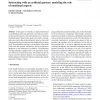Free Online Productivity Tools
i2Speak
i2Symbol
i2OCR
iTex2Img
iWeb2Print
iWeb2Shot
i2Type
iPdf2Split
iPdf2Merge
i2Bopomofo
i2Arabic
i2Style
i2Image
i2PDF
iLatex2Rtf
Sci2ools
BC
2008
2008
Interacting with an artificial partner: modeling the role of emotional aspects
In this paper we introduce a simple model based on probabilistic finite state automata to describe an emotional interaction between a robot and a human user, or between simulated agents. Based on the agent's personality, attitude, and nature, and on the emotional inputs it receives, the model will determine the next emotional state displayed by the agent itself. The probabilistic and time-varying nature of the model yields rich and dynamic interactions, and an autonomous adaptation to the interlocutor. In addition, a reinforcement learning technique is applied to have one agent drive its partner's behavior toward desired states. The model may also be used as a tool for behavior analysis, by extracting high probability patterns of interaction and by resorting to the ergodic properties of Markov chains.
| Added | 08 Dec 2010 |
| Updated | 08 Dec 2010 |
| Type | Journal |
| Year | 2008 |
| Where | BC |
| Authors | Isabella Cattinelli, Massimiliano Goldwurm, N. Alberto Borghese |
Comments (0)

